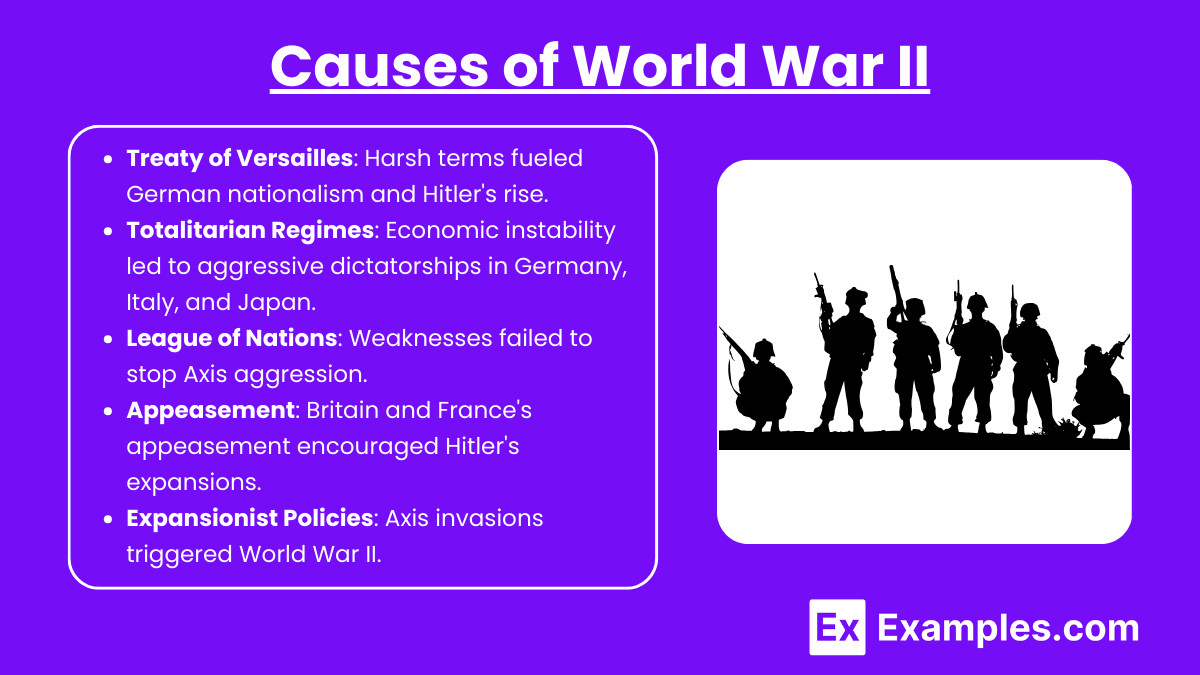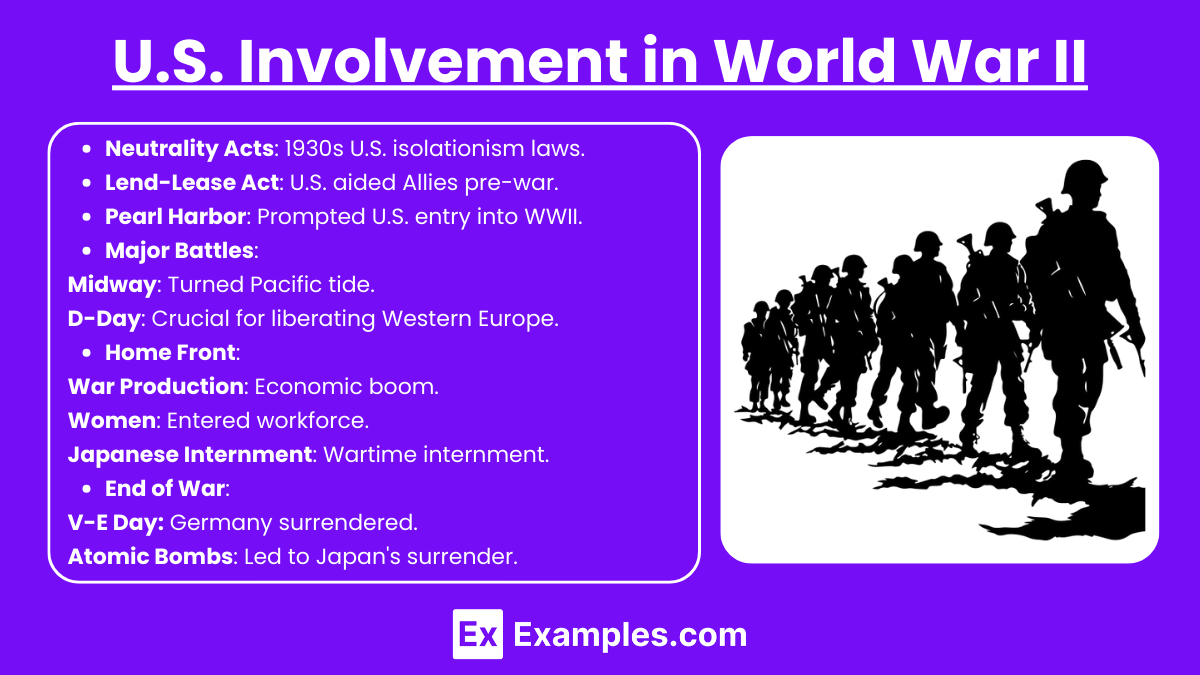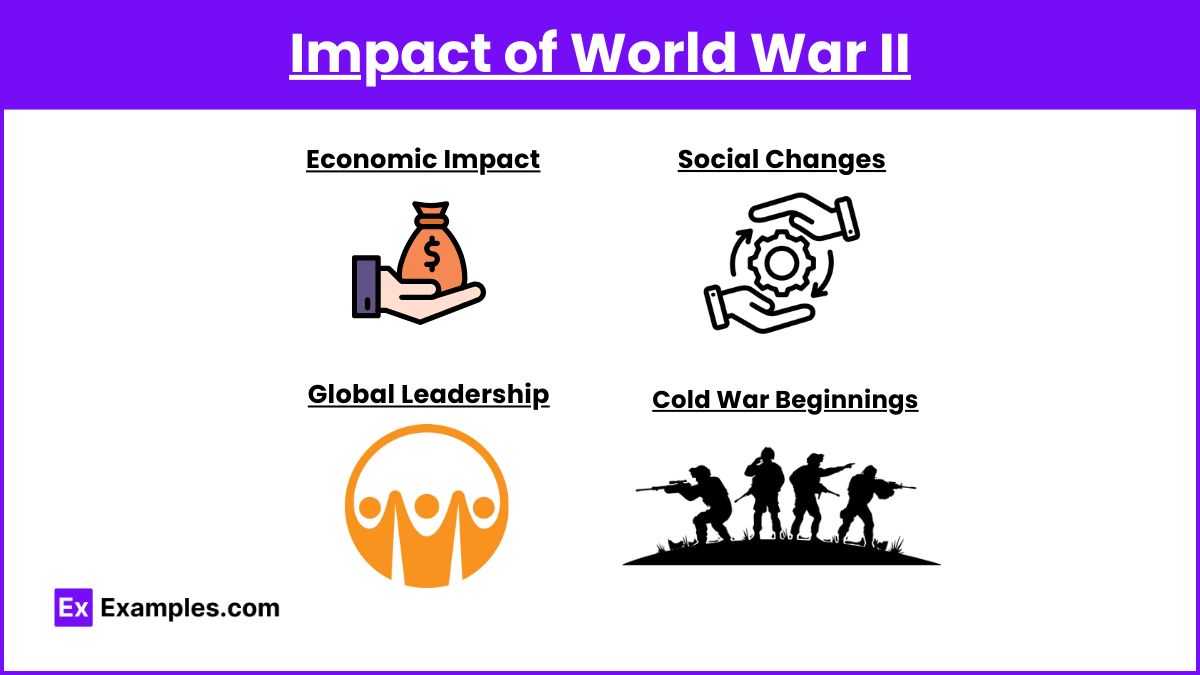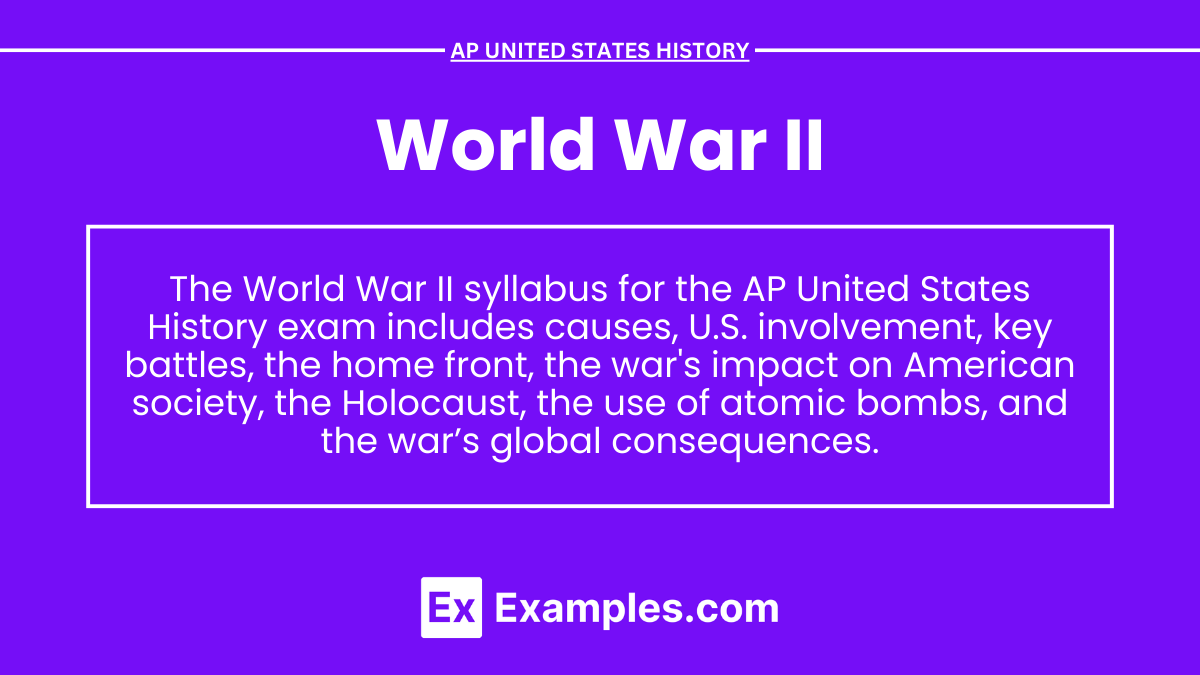In AP United States History, World War II is studied as a pivotal global conflict that reshaped the world order and marked the emergence of the United States as a dominant superpower. The war, spanning from 1939 to 1945, involved intense military, political, and economic engagements. It led to significant shifts in American society, including the end of the Great Depression, the mobilization of the home front, and the expansion of federal power. The U.S.’s involvement, triggered by the attack on Pearl Harbor, and its subsequent leadership in the Allied victory, profoundly influenced the post-war international landscape and set the stage for the Cold War.
Learning Objectives
In AP United States History, you will be expected to understand the causes and consequences of World War II, including the factors leading to U.S. involvement and the impact on American society and the global order. The roles of key battles, military strategies, and significant figures will be analyzed. Additionally, the effects of the war on the U.S. economy, social dynamics, and international relations, including the onset of the Cold War, will be evaluated.
Causes of World War II

- Treaty of Versailles (1919):
The harsh terms imposed on Germany after World War I, including severe reparations, territorial losses, and military restrictions, fueled German nationalism and resentment, paving the way for Adolf Hitler’s rise to power. - Rise of Totalitarian Regimes:
Economic instability and political turmoil after World War I led to the rise of totalitarian regimes in Germany (Hitler), Italy (Mussolini), and Japan (militarists), all of which pursued aggressive expansionist policies. - Failure of the League of Nations:
The League of Nations, established to maintain peace, was ineffective in stopping aggression by the Axis powers due to its lack of enforcement power and the absence of major powers like the U.S. - Appeasement:
European powers, particularly Britain and France, pursued a policy of appeasement, allowing Hitler to annex territories like Austria and the Sudetenland in hopes of avoiding another war. This emboldened Hitler to further aggression. - Expansionist Policies:
Japan’s invasion of China, Italy’s invasion of Ethiopia, and Germany’s invasion of Poland (1939) demonstrated the aggressive expansionist policies of the Axis powers, leading directly to the outbreak of World War II.
U.S. Involvement

- Neutrality Acts:
In the 1930s, the U.S. Congress passed a series of Neutrality Acts to prevent the nation from being drawn into foreign conflicts. These laws reflected strong isolationist sentiment in the U.S. after World War I. - Lend-Lease Act (1941):
Before officially entering the war, the U.S. supported the Allies through the Lend-Lease Act, which allowed the U.S. to send arms and supplies to countries vital to its defense, such as Britain and the Soviet Union. - Pearl Harbor (December 7, 1941):
The Japanese attack on Pearl Harbor in Hawaii led to the U.S. declaring war on Japan, and shortly after, Germany and Italy declared war on the U.S., marking America’s full entry into World War II. - Major Battles:
- Battle of Midway (June 1942): A decisive naval battle in the Pacific Theater that turned the tide in favor of the Allies.
- D-Day (June 6, 1944): The Allied invasion of Normandy, France, which was a significant step toward the liberation of Western Europe from Nazi control.
- Home Front:
- War Production: The U.S. transformed into the “Arsenal of Democracy,” rapidly converting peacetime industries into war production, leading to an economic boom.
- Women in the Workforce: Women entered the workforce in large numbers, symbolized by “Rosie the Riveter,” as men went off to fight.
- Japanese Internment: Executive Order 9066 led to the internment of Japanese Americans, a controversial decision that reflected wartime fears and racial prejudice.
- End of the War:
- Victory in Europe (V-E Day, May 8, 1945): Following the fall of Berlin and Hitler’s suicide, Germany surrendered, marking the end of the war in Europe.
- Atomic Bombs on Hiroshima and Nagasaki (August 1945): The U.S. dropped atomic bombs on these Japanese cities, leading to Japan’s surrender and the end of World War II.
Impact of World War II

- Economic Impact:
The war ended the Great Depression as wartime production boosted the economy. Post-war, the U.S. emerged as the world’s leading economic power. - Social Changes:
The war accelerated movements for civil rights and women’s rights, as African Americans and women had taken on new roles during the conflict. - Global Leadership:
The U.S. emerged from World War II as a superpower, taking a leading role in establishing the United Nations and shaping the post-war international order. - Cold War Beginnings:
Tensions between the U.S. and the Soviet Union, allies during the war, quickly escalated into the Cold War, a period of geopolitical rivalry that dominated the second half of the 20th century.
Examples
Example 1: Pearl Harbor Attack
The Japanese attack on Pearl Harbor was a pivotal moment, leading to the U.S.’s entry into World War II and significantly altering the course of the conflict.
Example 2: D-Day Invasion
The D-Day invasion was a critical Allied operation that began the liberation of German-occupied Western Europe and marked a turning point in the war.
Example 3: Lend-Lease Act
The Lend-Lease Act allowed the U.S. to support its allies with arms and supplies before officially entering the war, demonstrating its strategic commitment to defeating the Axis powers.
Example 4: Japanese Internment
The internment of Japanese Americans during the war reflected the wartime atmosphere of fear and prejudice, leading to significant civil liberties violations.
Example 5: The Manhattan Project
The Manhattan Project was the secret U.S. program to develop the atomic bomb, which ultimately led to the bombings of Hiroshima and Nagasaki and the end of the war with Japan.
MCQs
Which event directly led to the United States’ entry into World War II?
- A) The German invasion of Poland
- B) The signing of the Lend-Lease Act
- C) The attack on Pearl Harbor
- D) The Battle of Britain
Explanation: The Japanese attack on Pearl Harbor on December 7, 1941, directly prompted the U.S. to declare war on Japan, leading to its full involvement in World War II.
What was the purpose of the Lend-Lease Act?
- A) To provide military aid to Britain and the Soviet Union
- B) To maintain U.S. neutrality in the conflict
- C) To intern Japanese Americans during the war
- D) To regulate wartime production
Explanation: The Lend-Lease Act allowed the U.S. to supply arms and materials to allies like Britain and the Soviet Union, supporting them in the fight against the Axis powers before the U.S. officially entered the war.
Which of the following was a significant outcome of World War II for the United States?
- A) A return to isolationism
- B) Emergence as a global superpower
- C) Decline in industrial production
- D) Weakening of federal government power
Explanation: World War II established the U.S. as a global superpower, with significant influence in international affairs and a leading role in creating the post-war order.


